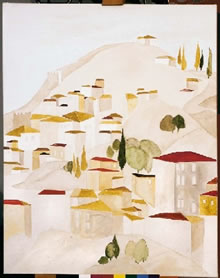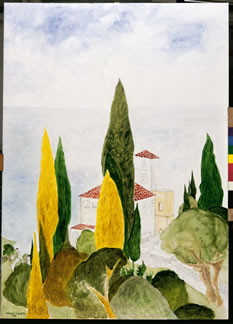Wassili Lepanto was lead to his art through his studies in literature and art. In contrast to many Germans whose longings brought them to the South, to Greece and Italy, the Greek Lepanto, born 1941 in Naftapkos (Lepanto), went to Germany, his country of longing.
In Heidelberg, the “Athens of the North” Lepanto, who grew up in Athens, went to university and found his second home. Heidelberg’s ensemble of landscape attracted many artists throughout centuries – Goethe recognizes “something ideal” in its topography – and Lepanto found his way as an artist. It is Heidelberg where his development into a politically and socially engaged human being is deeply rooted.
After having completed his studies of German Literature, Philosophie and Art History in 1978 as a Doctor of Philosophy he turned completely to painting, - even though the University of Athens had offered him a teaching position. He decided to stay in Heidelberg . “And this was,” as the philospher Gadamer said about Lepanto, “ like a new birth. He became a painter and it became obvious that he had been born to be a painter.”
Since 1978 Lepanto lives as an independent artist. He is consciously and firmly devoted to the genre of landscape, who was thought to be dead. In his different periods of painting he creates his paintings in warm yellow-and brown, his expressive red and green complementaries and those in meditative white. The wideranging panorama of his landscapes shows a concentration on “Kulturlandschaft”, landscape as shaped by man: the Greek mountains and shores, the landscape of Thessalia and of proud Toscany, but foremost German landscape. The Blackforest, Kraichgau and Northern Germany inspire him again and again in his search for the “idea of a landscape”. Heidelberg’s urban landscape holds another center in his work.
Along his exhibitions as in Paris, Wien, Bonn, Stuttgart, Helsinki, Athen, New York, Genf, Berlin und Florenz Wassili Lepanto writes on the theory of art. 1983 he lies the foundations of his “ecoligical art” in his manifesto “Kunst für den Menschen” (Art for man). It is a new evaluation of the development of art in the second half of the 20iest century. Many lectures given by the artist make Lepantos ideas and goals public. He teaches German Literature at the University of Heidelberg in 1991/1992. In 1993 his diary of an artist called “Vorfrühling” (Early spring) offers a good view on his work and thought. 1993-1995 Lepanto creates his polyptichon “Abendland” for the Palais Bunsen of the University of Heidelberg. His so far biggest painting (580/300cm) achieves to form “a bridge between two cultures who for a long time have stood apart in the Querelle des Anciens et Modernes”.
The retrospectives of 1997/1996 in the Palais of the United Nations in Geneva and in the Kunstpalast Düsseldorf are followed by the opening of Lepantos own galery in the old town of Heidelberg in 2000. Lepanto gathers 11.000 votes in 2001: a new weeping willow should replace the torn down old one in order to preserve the famous historic ensemble of the inner castle of Heidelberg. The edition Belser Stuttgart published “Wassili Lepanto – Positive Utopien”, a study on the painter and his work. Bündnis 90/Die Grünen (“Green party”) presents his paintings in their rooms in Berlin in summer 2003 and in december he takes part in the Biennale Internazionale dell’Arte in Florence as a represenative of painting in Germany.
The Kurpfälzische Museum exhibited works of Lepanto from all three phases of his artistic life in a retrospective. The RNZ wrote “Painted Confessions of Love” (27.02.2006).
2009 Lepanto travelled to Halifax in
Canada, to the Dalhousie University.
He gave a lecture on “Art and Ecology”.
Because of Heidelberg’s impending
council elections he founded a pressure
group called To Care for and to
Preserve Heidelberg [= Heidelberg Pflegen
und Erhalten]. The artist gained a
council seat.
Lepanto became a candidate for the
State Parliament of Baden-Württemberg
in the forthcoming elections of
27.03.2011.
Additional to all this political involvement
the artist has started to prepare
for retrospective of his life’s work
in his native city Athens, in the Benaki
Museum in spring 2011.


